建造者模式(Configuration)
构造者模式的定义是“将一个复杂对象的构建与它的表示分离,使得同样的构建过程可以创建不同的表示。”,它属于创建类模式,一般来说,如果一个对象的构建比较复杂,超出了构造函数所能包含的范围,就可以使用工厂模式和Builder模式,相对于工厂模式会产出一个完整的产品,Builder应用于更加复杂的对象的构建,甚至只会构建产品的一个部分。
构建Configuration对象过程
在Mybatis环境的初始化过程中,SqlSessionFactoryBuilder会调用XMLConfigBuilder读取所有的MybatisMapConfig.xml和所有的*Mapper.xml文件,构建Mybatis运行的核心对象Configuration对象,然后将该Configuration对象作为参数构建一个SqlSessionFactory对象。
其中XMLConfigBuilder在构建Configuration对象时,也会调用XMLMapperBuilder用于读取*Mapper文件,而XMLMapperBuilder会使用XMLStatementBuilder来读取和build所有的SQL语句。
在这个过程中,有一个相似的特点,就是这些Builder会读取文件或者配置,然后做大量的XpathParser解析、配置或语法的解析、反射生成对象、存入结果缓存等步骤,这么多的工作都不是一个构造函数所能包括的,因此大量采用了建造者模式来解决。
创建Cache对象的场景
在mybatis初始化mapper映射文件的过程中,为<cache>节点创建Cache对象的方式就是构造者模式。其中CacheBilder为建造者角色,Cache对象是产品角色,可以看CacheBuilder的源码来理解:

// 该类就是构造者 public class CacheBuilder { // 这几个属性就是为生成产品对象需要的字段 private String id; private Class<? extends Cache> implementation; private List<Class<? extends Cache>> decorators; private Integer size; private Long clearInterval; private boolean readWrite; private Properties properties; public CacheBuilder(String id) { this.id = id; this.decorators = new ArrayList<Class<? extends Cache>>(); } // 以下这几个方法就是构造者在生成产品对象时,需要使用到的几个具体模块方法。可以根据这几个方法的不同组合,生成不同的Cache对象 public CacheBuilder implementation(Class<? extends Cache> implementation) { this.implementation = implementation; return this; } public CacheBuilder addDecorator(Class<? extends Cache> decorator) { if (decorator != null) { this.decorators.add(decorator); } return this; } public CacheBuilder size(Integer size) { this.size = size; return this; } public CacheBuilder clearInterval(Long clearInterval) { this.clearInterval = clearInterval; return this; } public CacheBuilder readWrite(boolean readWrite) { this.readWrite = readWrite; return this; } public CacheBuilder properties(Properties properties) { this.properties = properties; return this; } // 这个方法就是构造者生成产品的具体方法 返回的Cahce对象就是产品角色 public Cache build() { setDefaultImplementations(); Cache cache = newBaseCacheInstance(implementation, id); setCacheProperties(cache); if (PerpetualCache.class.equals(cache.getClass())) { // issue #352, do not apply decorators to custom caches for (Class<? extends Cache> decorator : decorators) { cache = newCacheDecoratorInstance(decorator, cache); setCacheProperties(cache); } cache = setStandardDecorators(cache); } return cache; } }
装饰器模式(Cache)
Cache接口的实现有多个,但是大部分都是装饰器,只有PerpetualCache提供了Cache接口的基本实现,其他的装饰器都是在PerpetualCache的基础上提供了一些额外的功能,通过各种组合后满足一个特定的需求。如图:
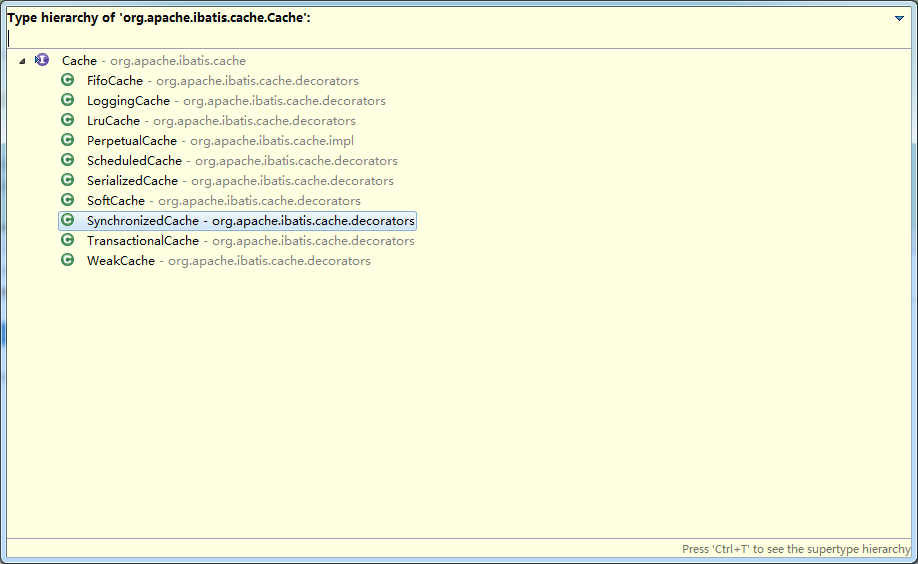
简单工厂模式(SqlSessionFactory)
在Mybatis中比如SqlSessionFactory使用的是工厂模式,该工厂没有那么复杂的逻辑,是一个简单工厂模式。
SqlSession可以认为是一个Mybatis工作的核心的接口,通过这个接口可以执行执行SQL语句、获取Mappers、管理事务。类似于连接MySQL的Connection对象。
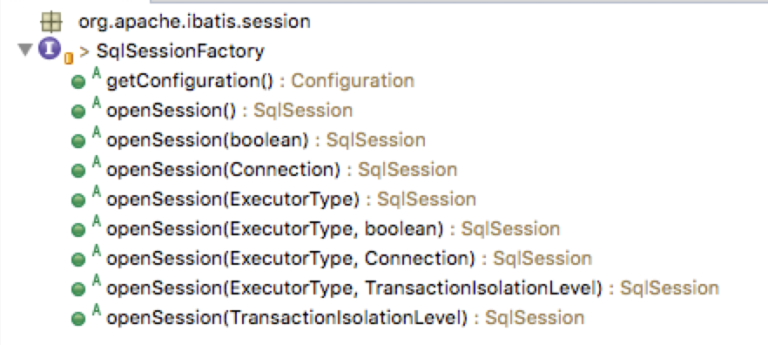

private SqlSession openSessionFromDataSource(ExecutorType execType, TransactionIsolationLevel level, boolean autoCommit) { Transaction tx = null; try { final Environment environment = configuration.getEnvironment(); final TransactionFactory transactionFactory = getTransactionFactoryFromEnvironment(environment); tx = transactionFactory.newTransaction(environment.getDataSource(), level, autoCommit); final Executor executor = configuration.newExecutor(tx, execType); return new DefaultSqlSession(configuration, executor, autoCommit); } catch (Exception e) { closeTransaction(tx); // may have fetched a connection so lets call // close() throw ExceptionFactory.wrapException("Error opening session. Cause: " + e, e); } finally { ErrorContext.instance().reset(); } }
这是一个openSession调用的底层方法,该方法先从configuration读取对应的环境配置,然后初始化TransactionFactory获得一个Transaction对象,然后通过Transaction获取一个Executor对象,最后通过configuration、Executor、是否autoCommit三个参数构建了SqlSession。
单例模式(ErrorContext)
ErrorContext:用于记录每个线程的执行环境错误信息。
LogFactory:提供给整个Mybatis使用的日志工厂,用于获得针对项目配置好的日志对象。

public class ErrorContext { private static final ThreadLocal<ErrorContext> LOCAL = new ThreadLocal<ErrorContext>(); private ErrorContext() { } public static ErrorContext instance() { ErrorContext context = LOCAL.get(); if (context == null) { context = new ErrorContext(); LOCAL.set(context); } return context; }
代理模式(*)(MapperProxy)
代理模式可以认为是Mybatis的核心使用的模式,正是由于这个模式,我们只需要编写Mapper.java接口,不需要实现,由Mybatis后台帮我们完成具体SQL的执行。
当我们使用Configuration的getMapper方法时,会调用mapperRegistry.getMapper方法,而该方法又会调用mapperProxyFactory.newInstance(sqlSession)来生成一个具体的代理:

public class MapperProxyFactory<T> { private final Class<T> mapperInterface; private final Map<Method, MapperMethod> methodCache = new ConcurrentHashMap<Method, MapperMethod>(); public MapperProxyFactory(Class<T> mapperInterface) { this.mapperInterface = mapperInterface; } public Class<T> getMapperInterface() { return mapperInterface; } public Map<Method, MapperMethod> getMethodCache() { return methodCache; } @SuppressWarnings("unchecked") protected T newInstance(MapperProxy<T> mapperProxy) { return (T) Proxy.newProxyInstance(mapperInterface.getClassLoader(), new Class[] { mapperInterface }, mapperProxy); } public T newInstance(SqlSession sqlSession) { final MapperProxy<T> mapperProxy = new MapperProxy<T>(sqlSession, mapperInterface, methodCache); return newInstance(mapperProxy); } }
在这里,先通过T newInstance(SqlSession sqlSession)方法会得到一个MapperProxy对象,然后调用T newInstance(MapperProxy<T> mapperProxy)生成代理对象然后返回。
public class MapperProxy<T> implements InvocationHandler, Serializable { @Override public Object invoke(Object proxy, Method method, Object[] args) throws Throwable { try { if (Object.class.equals(method.getDeclaringClass())) { return method.invoke(this, args); } else if (isDefaultMethod(method)) { return invokeDefaultMethod(proxy, method, args); } } catch (Throwable t) { throw ExceptionUtil.unwrapThrowable(t); } final MapperMethod mapperMethod = cachedMapperMethod(method); return mapperMethod.execute(sqlSession, args); }
非常典型的,该MapperProxy类实现了InvocationHandler接口,并且实现了该接口的invoke方法。
通过这种方式,我们只需要编写Mapper.java接口类,当真正执行一个Mapper接口的时候,就会转发给MapperProxy.invoke方法,而该方法则会调用后续的sqlSession.cud>executor.execute>prepareStatement等一系列方法,完成SQL的执行和返回。
组合模式(SqlNode)
SqlNode和各个子类ChooseSqlNode。
Mybatis支持动态SQL的强大功能,比如下面的这个SQL:

<update id="update" parameterType="org.format.dynamicproxy.mybatis.bean.User"> UPDATE users <trim prefix="SET" prefixOverrides=","> <if test="name != null and name != ''"> name = #{name} </if> <if test="age != null and age != ''"> , age = #{age} </if> <if test="birthday != null and birthday != ''"> , birthday = #{birthday} </if> </trim> where id = ${id} </update>
在这里面使用到了trim、if等动态元素,可以根据条件来生成不同情况下的SQL;
在DynamicSqlSource.getBoundSql方法里,调用了rootSqlNode.apply(context)方法,apply方法是所有的动态节点都实现的接口:
public interface SqlNode { boolean apply(DynamicContext context); }
对于实现该SqlSource接口的所有节点,就是整个组合模式树的各个节点:
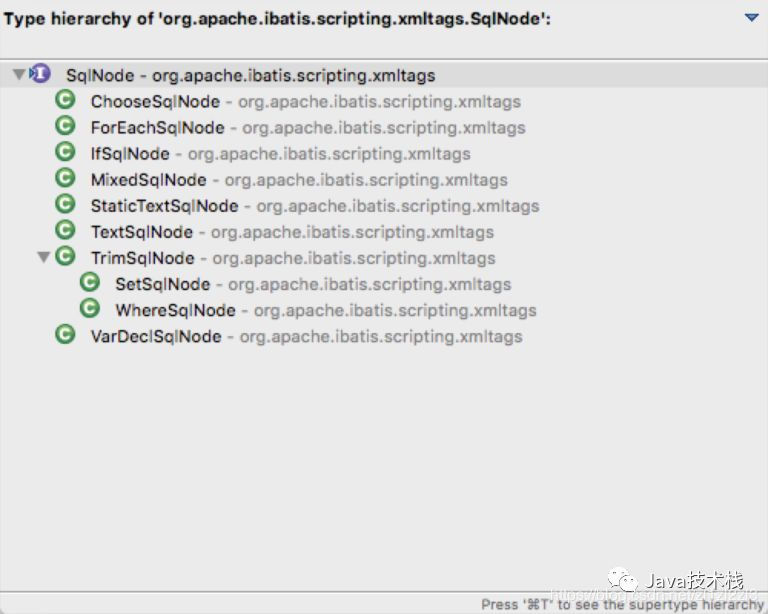
组合模式的简单之处在于,所有的子节点都是同一类节点,可以递归的向下执行,比如对于TextSqlNode,因为它是最底层的叶子节点,所以直接将对应的内容append到SQL语句中:
@Override public boolean apply(DynamicContext context) { GenericTokenParser parser = createParser(new BindingTokenParser(context, injectionFilter)); context.appendSql(parser.parse(text)); return true; }
但是对于IfSqlNode,就需要先做判断,如果判断通过,仍然会调用子元素的SqlNode,即contents.apply方法,实现递归的解析。
@Override public boolean apply(DynamicContext context) { if (evaluator.evaluateBoolean(test, context.getBindings())) { contents.apply(context); return true; } return false; }
模板模式(BaseExecutor)
模板方法模式是所有模式中最为常见的几个模式之一,是基于继承的代码复用的基本技术。
在Mybatis中,sqlSession的SQL执行,都是委托给Executor实现的,Executor包含以下结构:
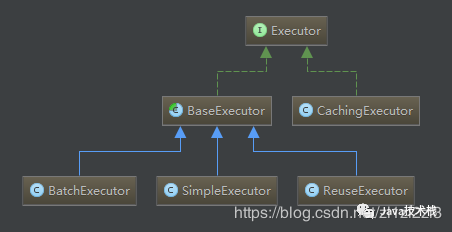
其中的BaseExecutor就采用了模板方法模式,它实现了大部分的SQL执行逻辑,然后把以下几个方法交给子类定制化完成:
protected abstract int doUpdate(MappedStatement ms, Object parameter) throws SQLException; protected abstract List<BatchResult> doFlushStatements(boolean isRollback) throws SQLException; protected abstract <E> List<E> doQuery(MappedStatement ms, Object parameter, RowBounds rowBounds, ResultHandler resultHandler, BoundSql boundSql) throws SQLException;
该模板方法类有几个子类的具体实现,使用了不同的策略:
-
简单SimpleExecutor:每执行一次update或select,就开启一个Statement对象,用完立刻关闭Statement对象。(可以是Statement或PrepareStatement对象)
-
重用ReuseExecutor:执行update或select,以sql作为key查找Statement对象,存在就使用,不存在就创建,用完后,不关闭Statement对象,而是放置于Map<String, Statement>内,供下一次使用。(可以是Statement或PrepareStatement对象)
-
批量BatchExecutor:执行update(没有select,JDBC批处理不支持select),将所有sql都添加到批处理中(addBatch()),等待统一执行(executeBatch()),它缓存了多个Statement对象,每个Statement对象都是addBatch()完毕后,等待逐一执行executeBatch()批处理的;BatchExecutor相当于维护了多个桶,每个桶里都装了很多属于自己的SQL,就像苹果蓝里装了很多苹果,番茄蓝里装了很多番茄,最后,再统一倒进仓库。(可以是Statement或PrepareStatement对象)
比如在SimpleExecutor中这样实现update方法:
@Override public int doUpdate(MappedStatement ms, Object parameter) throws SQLException { Statement stmt = null; try { Configuration configuration = ms.getConfiguration(); StatementHandler handler = configuration.newStatementHandler(this, ms, parameter, RowBounds.DEFAULT, null, null); stmt = prepareStatement(handler, ms.getStatementLog()); return handler.update(stmt); } finally { closeStatement(stmt); } }
适配器模式(Log)
适配器模式(Adapter Pattern) :将一个接口转换成客户希望的另一个接口,适配器模式使接口不兼容的那些类可以一起工作,其别名为包装器(Wrapper)。适配器模式既可以作为类结构型模式,也可以作为对象结构型模式。
在Mybatsi的logging包中,有一个Log接口:

/** * @author Clinton Begin */ public interface Log { boolean isDebugEnabled(); boolean isTraceEnabled(); void error(String s, Throwable e); void error(String s); void debug(String s); void trace(String s); void warn(String s); }
该接口定义了Mybatis直接使用的日志方法,而Log接口具体由谁来实现呢?Mybatis提供了多种日志框架的实现,这些实现都匹配这个Log接口所定义的接口方法,最终实现了所有外部日志框架到Mybatis日志包的适配:
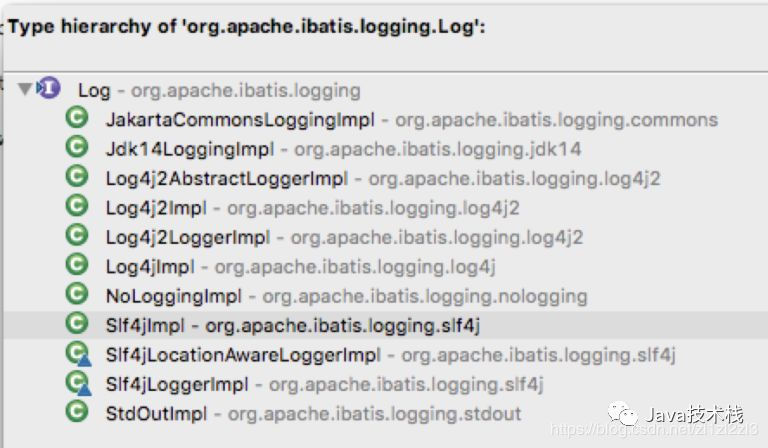
比如对于Log4jImpl的实现来说,该实现持有了org.apache.log4j.Logger的实例,然后所有的日志方法,均委托该实例来实现。

public class Log4jImpl implements Log { private static final String FQCN = Log4jImpl.class.getName(); private Logger log; public Log4jImpl(String clazz) { log = Logger.getLogger(clazz); } @Override public boolean isDebugEnabled() { return log.isDebugEnabled(); } @Override public boolean isTraceEnabled() { return log.isTraceEnabled(); } @Override public void error(String s, Throwable e) { log.log(FQCN, Level.ERROR, s, e); } @Override public void error(String s) { log.log(FQCN, Level.ERROR, s, null); } @Override public void debug(String s) { log.log(FQCN, Level.DEBUG, s, null); } @Override public void trace(String s) { log.log(FQCN, Level.TRACE, s, null); } @Override public void warn(String s) { log.log(FQCN, Level.WARN, s, null); } }
迭代器模式
迭代器(Iterator)模式,又叫做游标(Cursor)模式。GOF给出的定义为:提供一种方法访问一个容器(container)对象中各个元素,而又不需暴露该对象的内部细节。
Java的Iterator就是迭代器模式的接口,只要实现了该接口,就相当于应用了迭代器模式。
Mybatis的PropertyTokenizer是property包中的重量级类,该类会被reflection包中其他的类频繁的引用到。这个类实现了Iterator接口,在使用时经常被用到的是Iterator接口中的hasNext这个函数。
